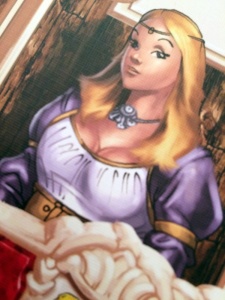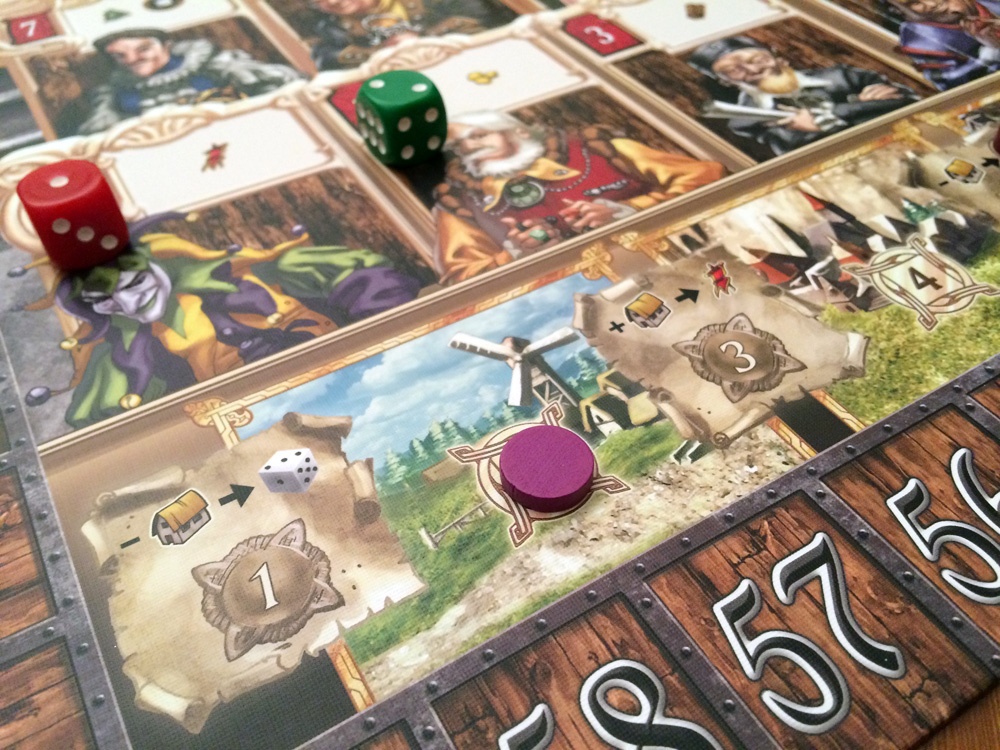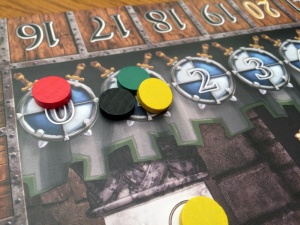 I can’t imagine it was easy to be a territorial governor in the Middle Ages. Imagine dealing with all the issues they had to deal with; like the demands of your King, keeping the peasants happy and placing dice to influence the King’s advisors. Maybe that last one didn’t exist in the real world, but it does in Kingsburg.
I can’t imagine it was easy to be a territorial governor in the Middle Ages. Imagine dealing with all the issues they had to deal with; like the demands of your King, keeping the peasants happy and placing dice to influence the King’s advisors. Maybe that last one didn’t exist in the real world, but it does in Kingsburg.
Kingsburg is a dice rolling and worker placement game where players are attempting to earn the favor of the king. Players will have to work quickly to change their lands into booming medieval villages to earn victory points to win the game. In order to do this, players will have to influence the king’s advisors to give you commodities, defensive protection, or victory points. Kingsburg isn’t a new game, as it was released by Fantasy Flight in 2007; however, it still has one of the unique uses of dice I have seen in a game. Does that mechanic lead to a solid game? Read on to find out.
Kingsburg is a two to five player game that plays in about 90 minutes. In my experience, the game plays best with four or five players.
Game Overview:
You and your fellow players are newly appointed governors of King Tritus’ new territory. He has given you five years to take an undeveloped province of land into one of the jewels of his empire. Each year there will be three producing seasons where players will roll their dice. The dice will be used to call upon the help of the King and his advisors, each of which have specific goods or skills that could help in your quest. The issue is these advisors are typically only able to help one player per season. Players will have to use their dice effectively to gain resources, erect buildings and build up their armies against enemies that will attack their land. The player who is able to earn the most victory points at the end of five years will be rewarded with a position among the King’s trusted advisors and wins the game.
Components:

Kingsburg is published by Fantasy Flight Games, so you know that the components are awful. I’m kidding, they are amazing. The dice, tokens, and goods cubes are all great. There are two specific things that I want to highlight about the components, first being the artwork. This game is set in a medieval time and the art direction fits that quite well. Each of the advisors has a different role, such as jester, duchess and wizard and the art and graphic design does a nice job of bringing those roles to life.
The other thing I want to point out about the components is the layout of the main board. Everything is laid out fantastically and efficiently. The board has spaces for goods, tokens, a calendar and season track, turn order, soldiers chart and a victory point track all within a normal sized game board. Admittedly, it does make the board feel a little cluttered, but during the game, you never feel like there isn’t enough room.
In addition, I love how the advisor court is set up in the middle of the board. Each one sitting in their chairs with the most trusted advisors sitting closest to the king as they look down on you as you ask for their help. It’s not something people normally talk about in a review, but it has to be one of my favorite game boards.
How to Play:
Players will first get their color set of six-sided dice, building tokens, a good of their choosing and place their disc tokens on the turn order, victory point track, and the soldiers track. They will also receive a province sheet that contains the list of building they can build during the game. These buildings are the primary source of victory points in the game. As players build their buildings, they will gain a benefit. These benefits include increasing the number of soldiers you have, rolling an extra die, adjusting the total on your dice, exchanging goods for victory points, and many other things. Each province sheet is the same with the only requirement that you build left to right across the rows. Each of the five rounds in Kingsburg is separated into eight phases:
1. Aid from the King
The player with the fewest constructed buildings will be allowed to roll a white die in phase two. This die can only be used with a color die to influence an advisor.

2. Spring – First Productive Season
Each productive season has four steps carried out by all players for the spring, summer and autumn phases. First players will roll all of their dice and determine the turn order. The player with the lowest cumulative total is the first player to go with the rest of the turn order going in ascending order.
In turn order, players will place one or more of their dice to exactly match the advisor’s value. Once an advisor is claimed, no other player may place his or her dice there. Once all players are done placing dice or unable to, they will receive the items next to the advisor.
The final step of each productive season is to construct buildings. Each player is allowed to construct one building on their turn. Players pay the building cost with the goods they have collected from the advisors and place a building token of their color on their province sheet. They earn the victory points for the building, if applicable.
3. The King’s Reward
The player or players who has built the most buildings to this point of the game earns a victory point. Your king is pleased with your progress.
4. Summer – Second Productive Season
5. The King’s Envoy
The player with the fewest buildings built at this point of the game is awarded the King’s Envoy marker. This allows the player to build two buildings in one season or influence an advisor that has already been influenced. Once you spend the marker on one of these actions you lose it.
6. Autumn – Third Productive Season
7. Recruit Soldiers
Each player has the opportunity to hire soldiers for the upcoming invasion. Players may pay two goods to increase their soldier chart which will help them defend their province in phase 8.

8. Winter – The Battle
In this phase, you face the invading army of enemies that your scouts have been warning you about. The enemy deck is made up of five cards with enemies of increasing strength. There is a strength range listed on the card that players can see during that year. Depending on how the battle goes these cards can either gain you a resource or have many bad things happen to you. In order to stop that from happening, players will move their token up the soldier track equal to the number of defenses they have earned from buildings, any they have earned from advisors this year or purchased in phase seven.
Then the first player on the turn order chart rolls a die. Each player receives that many soldiers from King Tritus and moves their token accordingly. The card will now be flipped over and the enemy is revealed. If you match the value on the card, nothing happens. If you have a higher value, you gain what is in the blue box, but if you are lower, you suffer all the penalties in the red box.
These phases will continue for five rounds and the player with the most victory points at the end of the game wins.

Game Experience:
The first time I heard of Kingsburg I was just getting into the board gaming hobby. I added it to my wish list for games, but didn’t place it very high on the priority list. I filled out my early collection with what my friends considered staple games, and Kingsburg got pushed further down the list. When I got the game earlier this year, I regretted not having this game in my collection sooner because it is fantastic.
Kingsburg is a light game. Even though my how to play section seems a little long, it encompasses the entire game. There are no complicated rules or cards that players have to understand to start succeeding and playing the game. At its core, the game is: roll dice, gain resources and spend them to earn victory points and special abilities. Despite being a very simple game to teach, it plays well with an experienced gaming group.

The first time I played Kingsburg was in a more casual setting. We were mostly focused on our own building and didn’t care too much about what the other player rolled or might be doing. When I played with my weekly gaming group, the gloves came off. Players were intentionally blocking spots early to prevent other players from placing their dice on the board and it became a badge of honor when you could stop someone from placing all of their dice. It is very rare that a light game can be played with distinct play styles and still is enjoyable. Ticket to Ride is another game that accomplishes this feat.
Kingsburg is very well-balanced with both the advisor rewards and the building powers. When you look at the board, it is clear you want to roll high, however, if you roll low it doesn’t mean you are out of the game. Getting those high value spots requires players to unload all of their dice leaving the lower spots open for players to claim. This allowed for a player in one of my games who was consistently the low total player to be only a few victory points off the leader at the end of the game.
What also helps this balance is the buildings. With twenty buildings for a player to forge, it allows for you to adjust your strategy based on the goods you have gained. It was rare that you are stuck not doing anything within the first three rounds of the game. I love what the buildings can do for you during the game. Each one gives the player something unique, and a clear advantage versus the other players, if they are able to build it early in the game. With all the possibilities of the order of these buildings being completed, it allows each game to feel a little different. Unfortunately, it is with the buildings that I have my biggest complaint about the game.
My issue is that every player has the exact same building that they can construct during the game. This doesn’t make the game boring or unplayable after a few games, but I feel that this is a missed opportunity. Having different buildings for each player would allow this game to be more strategic and move it to a medium weight euro game. I do want to mention that there’s an expansion for Kingsburg that I have not played that adds a few new things to the game including allowing each players to customize the buildings they can erect.

The other little thing that I don’t like about the game is a lack of victory point counters. Personally, I like to be able to total all my victory points at the end of the game. When I’m required to move my token up and down a victory point tracker I tend to forget to do so at least once in the game. It’s easy to calculate the total from the buildings you have constructed during the game, but I would liked to have something physical to represent the other victory points I have earned. I did add my own tokens to the game and makes the point totaling much easier.
The game plays very differently depending on the player count. With a two or three player game, there are more spots for players to claim on their turn. Four and five player games have more competition for those advisors causing more frustration and changing of strategies because of what the other players have done. I personally like the game at the higher player counts, but it plays fine with two or three. I do want to mention that I like the two player rules for the game. I don’t like when games force the other players to make extra decisions for the ghost players. In Kingsburg, players roll three and two dice of unused colors and place them on the advisor that matches the total. It doesn’t add much time to the game and is purely random which I like. When you add more players to the game it does add to the time it takes to play, but it never seems that way. In every game I have played, I’m always shocked at the amount of time that has passed. Because the game has no slowdown or dragging moments, time seems to fly. It takes a remarkable game to keep you engaged as much as Kingsburg does.
Final Thoughts:
I love Kingsburg and I’m not afraid to admit it. It has very simple mechanics, but enough strategic decisions and player interaction to keep everyone engaged. Because the dice rolls are never the same, you will never influence the same advisors as previous games keeping Kingsburg a fresh experience. Personally, I could have used a few more options for buildings but that doesn’t detract from the game. I used to use Ticket to Ride as my go to game to introduce people to the hobby. Since I have owned Kingsburg, it has started to find its way into that rotation. If you are looking for a game that will be enjoyed by your gaming group and your family, pick up Kingsburg.
If you are interested in getting a copy for yourself, you can get it for about $38.
Final Score: 4.5 Stars – Combining both simple mechanics and an interesting use of dice rolling allows Kingsburg to be a game that I will gladly have in my collection.
 Hits:
Hits:
• Unique use of dice
• Excellent balance of advisers and building powers keeps game close
• Time flies when you play it
Misses:
• Lack of building diversity
• Randomness of dice rolls























the expansion fixes your ‘lack of building diversity’ issue.
I did mention in the review that FFG put out an expansion that should deal with the building diversity issue. However, I’m not reviewing the expansion and I can only go on what is in the box. The expansion is on my wish list to try out.
Thanks for the great review! How would you rate this game against Stone Age & The Manhattan Project? I need to pick one of the three to begin with
If you are looking for a light weight worker placement game, I’d recommend Stone Age, Kingsburg, or Lords of Waterdeep. Any of those three are perfect games if you want a light weight one. Of the three, I’d say to pick the theme that most interests you.
I agree with Tony. I think all of them are great worker placement games. Of the three you mentioned, I would get Stone Age or Kingsburg before The Manhattan Project.
How do you feel this compares with Castles of Burgundy? (which I love)